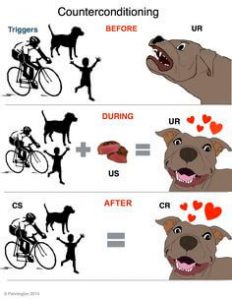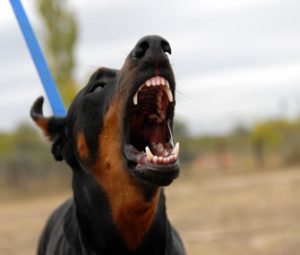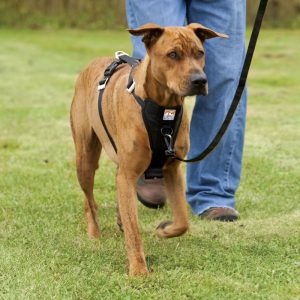Hi Meira,
I really need your help, I have a great dog but when I walk him, he is very aggressive with other dogs. When he sees another dog he goes crazy barking and lunging like mad at the other dog. I have tried treats to distract him, but it doesn’t seem to work. It’s really getting quite embarrassing, and I end up taking him out at quieter times when I think there won’t be other dogs out.
Billy is a 4 year old pit bull, and is usually a super sweet dog, except when he sees another dog. He is great with people, and he loves our kids. It’s just this aggressive behavior is really driving me crazy.
I hope you can give me some tips or advice please!
Stacey
Hi Stacey,
Thanks for writing in with your question. Leash reactiveness is actually a very common issue with dogs; it’s probably one of the biggest issues I deal with my clients. I would first advise that you contact a local qualified trainer in your area to help you evaluate your dog to determine his real issues, and to help you in person. I can give you tips and advice, but without more information, and an evaluation, it would be hard for me to determine what the real issues are.
Billy may be leash reactive, or he may just be a frustrated greeter. And those two issues aren’t dealt with in the same manner. Based on the information you gave me, I will treat this as leash reactivity, but again, please bring in a trainer who can help determine the real issues.
As you may already know, most cases of aggression are actually rooted in fear. A lot of people feel that their dog might be in protection mode, and are just trying to protect them. While this might be true in some cases, this is usually not the case. Most dogs are just looking to protect themselves. Keep in mind that a dog’s priority is ensuring that it is safe. Dogs will do all they can to make sure that they stay safe.
The lunging and the barking is your dog’s way of telling the other dog to back off, or stop moving. It’s a distance increasing signal, where the barking dog is asking for distance. When dogs communicate, all they usually say is either Come Closer, or Move Away.
Being on leash can come sometimes exasperate the issue, as the dog no longer has the choice to do what he might want to do. I’m sure you’ve heard the term Fight or Flight. When an animal, or us, is in an unsure situation, the choices are Fight, Flight or Freeze. When a dog is constrained on a leash, we’ve effectively removed the flight and sometimes the freeze option as well.
When this happens, we are usually moving towards the other dog, or the other dog is moving towards us, in a pretty straight line. The reactive dog usually asks the other dog for distance with signals that many of us are oblivious to, and we just move the dogs closer together, decreasing the distance between them, which just increases the emotions of the reactive dog, and sometimes of the other dog as well.
I’m not sure what type of collar or leash you walk your dog with, but different tools can affect the situation as well. I would suggest a front clip harness rather than attaching the leash to a collar. If when encountering another dog our dog feels a jolt on the neck due to pulling against a collar, the dog may very well be making a negative association with other dogs. The reactive dog may not realize that his lunging behavior is what causes the jolt to his neck, but rather, that this painful jolting happens when other dogs are around.
When he is alone, no painful neck jolts. These jolts happen when he sees other dogs. We need to be mindful of how our dogs are making associations, both negative and positive.
While helping a dog to feel less reactive takes time, there are often management tools that I often teach my clients, mainly leash handling skills. Teaching an emergency U turn is often very helpful, to get a reactive dog to move away from the trigger of the other dog is an excellent choice, as it breaks the visual, which is important. I also advise using the environment to break visuals as well, such as turning around, or ducking behind a car, or walking up a driveway. Anything to increase distance, as that is what the reactive dog is searching and working for.
If there is no choice, then walking in an arc around the other dog is preferable. Many people try to have their dog sit calmly while the other dog passes. This isn’t something I usually recommend though as this is often too much to ask of the reactive dog. They often just get more aroused. If I’m scared of spiders, asking me to sit still while it walks close to me would be very hard for me. I would just want to put as much distance as I could between myself and the spider.
A lot of people advise giving treats to the reactive dog when it sees another dog. While the idea is great, you already know that it doesn’t always work. When a dog is fearful and too close to their trigger, the last thing on their mind is food. When presented with a fearful situation, the digestive system actually shuts down, allowing energy to go where it is most needed, which is usually to get away or fight.
The key here is distance and proximity to the trigger. Every dog has a threshold, a distance that is far away enough from the trigger where the dog doesn’t feel the need to react. This is the distance point where we can give treats to the dog to help him make a positive association with the trigger.
Some dogs need 20 feet, others 50 feet and others need the length of a whole football field. The important thing is learning how to read your dogs threshold. This distance isn’t always the same though, and can change based on a variety of things, such as the behavior of the trigger, where the trigger  is facing, things in the environment, as well as the emotional state of our dog. This is where knowing how to effectively read dog body language is important.
is facing, things in the environment, as well as the emotional state of our dog. This is where knowing how to effectively read dog body language is important.
If your dog is far enough away, and not reacting, this is the perfect time to give very high value treats. Not just the regular treats you use in training, but really high value so the association is more pronounced.
This is where you should get a trainer in to help you with Systematic Desensitization and Counter Conditioning though. Counter Conditioning is where you are working to chance the dog’s emotion towards the trigger. You basically pair something off the charts amazing with the trigger, such as chicken, cheese, bacon…something that the dog really loves and doesn’t get in other situations.
Trigger appears, bacon rains from the sky. Trigger leaves, raining bacon stops. It sounds simple, but timing, mechanics and handling are critical to ensuring the protocol works effectively. This is where hiring a trainer who is qualified and experienced with CC and DS is important. It has nothing to do with rewarding good or calm behavior, but rather has everything to do with changing the emotional perception to the trigger in the reactive dog.
I hope these tips help you some, but I would advise getting a dog trainer in to teach you how to carry things out properly. If you need any more help, please feel free to get in touch with me, or any other qualified professional close to you.
Good luck and Happy Training!
Meira
 Montreal Dog Blog Montreal's Online Dog Park
Montreal Dog Blog Montreal's Online Dog Park






